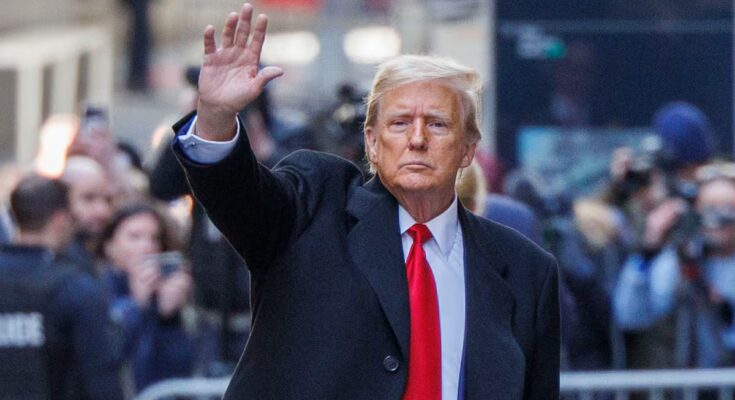Just as he claims to have stopped seven wars since coming to power, Donald Trump may well get to hang up the badge of Wall Street’s best men this year, a little lackluster in the final stretch of this week. The S&P managed to recover 35% from the lows to which the American president himself had caused the index to plummet by declaring trade war on the world and this year it added a revaluation of 15%. The 2025 balance aims to be slightly lower than the increase of the previous two years, but it will be the third consecutive year of profits hovering around 20% and all this despite the innovative policy implemented by Trump. The latest example: the shutdown of the US administration which was the longest in the country’s history.
Investors’ attention is now on corporate profits, which have shown unexpected strength, and on artificial intelligence with its lights and shadows: euphoria over the promise of greater productivity on a global scale and higher incomes and the fear that the fruits of AI will arrive later than expected, calling into question multi-billion investments. Indeed, this concern is making its way into the market and caused this Thursday the biggest drop of the month for the Nasdaq, which had already suffered the biggest drop since April the previous week. The week ends with fears of an AI bubble on the surface, compounded by doubts that the Fed will cut interest rates in December. The market already gives less than 50% probability of such a reduction.
Trump has fallen several places on investors’ list of concerns, which have outweighed the devastating impact of his April announcement of high tariffs on all of the United States’ trading partners. Also the approval of a tax reform that extends the tax cuts of his first term and which will increase the country’s public deficit – turning the growing level of debt into a potential threat for the coming years – and the blatant interference in the Federal Reserve, under enormous pressure to cut interest rates according to Trump’s wishes.
His economic program has helped accelerate the decline of the dollar, weakened not only by falling rates but by a previously unknown suspicion of US assets and which has also been reflected in a lower appetite for US sovereign debt. With Trump, the debate has opened on the end of American exceptionalism, in which the USA offers unique opportunities, more attractive than any other market, for investments. Added to this cocktail of upheavals in the financial status quo is the geopolitical instability stirred up by Trump on the international scene, with his irregular approaches to Russia or his recent conflict with Venezuela.
The blood has not reached the river and the dollar undoubtedly remains the undisputed reference currency worldwide and the Fed and Wall Street continue to be the lighthouse guiding investments globally. The market has weathered Hurricane Trump and investors appear to have become accustomed to the back and forth of his policies, with real threats like those issued with tariffs being lowered soon after. This is what is already known as the TACO tactic (Trump always backs down), that is, according to the English translation, that Trump always backs down in the end. “Trump is saved by the fever for artificial intelligence and lower energy prices,” summarizes Roberto Scholtes, head of strategy at Singular Bank, who also recognizes that “the moment of maximum uncertainty due to Trump’s policies is behind us, while the American economy has continued to grow”.
Analysts agree that the key to Wall Street’s recovery lies in corporate results, also reflecting that measures that were feared would have a serious impact, such as tariffs, are not causing the expected damage. As of early November, 83% of Wall Street companies reporting quarterly numbers had exceeded analysts’ consensus earnings per share expectations, above the annual average of 77% and the five-year average of 78%, according to Link Securities.
Citi adds that the market’s good reaction to company results has not so much to do with specific data from the third quarter, but with the progress made by companies on year-end results and estimates for 2026. “A simple result above expectations in the third quarter is not enough to trigger superior performance,” explains the American bank. “We have argued in recent months that the S&P 500 upside in 2025 is based on earnings trajectories for 2026. This was the clearest way to address the ongoing valuation concern,” insists Citi.
Manuel Pinto, analyst at XTB, agrees that corporate results have become the big catalyst for stock markets, both in the US and Europe. Factors such as rate cuts, although anticipation of a final Fed cut in the US has cooled recently, AI investment fever, and seasonality also contribute. “According to data going back to 1926, November is on average the second best month of the year for the S&P 500, surpassed only by July. If history is any guide, November starts the sixth best month of the year for U.S. stocks,” explains Pinto. This time, sticking to that script is a little more challenging after one of the S&P 500’s biggest rallies in a six-month period since the 1950s.
Analysts and managers also point to a kind of unwritten pattern that has guided Trump’s relationship with the markets in recent months and the reason why investors ended up adopting this measure. The sequence begins with a harsh tariff threat, which results in stock market crashes, followed shortly thereafter by a slightly more reassuring message – almost always from Trump on his social network – and then negotiations begin which end in a less bad deal than expected. That’s what happened with Trump’s latest tariff threat to China, issued on a Friday in mid-October. “On Sunday, before the opening of the futures, Trump lowers his tone. So the most followed strategy is buy the sauce“, to take advantage of cheaper purchases”, adds Pinto. In this sense, Scholtes adds that the messages of Treasury Secretary Scott Bessent, “a more pragmatic voice, with a more orthodox vision”, are gaining weight in the economic messages of the White House, “a more pragmatic voice, with a more orthodox vision”. And after Trump’s volcanic eruption with his trade war, the interdependence of the US and China economies has also become evident, reflected in the momentum that both powers maintain on semiconductors and land. “The market has internalized Trump’s negotiating tactics,” adds Scholtes.
Waiting for Nvidia
The results season, which is sealing an unquestionably bullish year, will have its culminating moment on Wednesday the 19th with the results of Nvidia, the queen of artificial intelligence thanks to its dominance in chip production and which has reached the unusual valuation of 5 billion dollars. “I do not expect disappointment with Nvidia’s results, but I see the risk of a correction in technological values. The benefits thanks to the development and application of artificial intelligence will undoubtedly come, but the return on the enormous investments made may take longer than expected”, summarizes Jacobo Blanquer, CEO of Tressis Gestión.
In one part of the market, doubts about artificial intelligence have already been resolved. Investors do not doubt its enormous potential or the reality of the millionaire profits that the sector already generates, but they are starting to distrust the speed with which the huge investors launched by giants like Meta or Oracle, which have already resorted to issuing debt to finance them, will bear fruit. Michael Burry, the famous investor who anticipated the mortgage crisis subprime In the US he has already warned against creating a bubble around artificial intelligence and has taken bearish positions on Palantir and Nvidia. Semiconductor companies lost half a billion dollars in the Nov. 4 session, and this week Oracle is down 10% in three days and Nvidia is down 7%.
Nvidia’s results will therefore be the thermometer against which to measure what is today the main concern of investors, even if Trump and his policies could return to the foreground at any moment. For Thomas Friedberger, CEO and co-chief investment officer of Tikehau Capital, Trump has opened a Pandora’s box by questioning the rule of law in the United States, which in his opinion “calls into question one of the foundations of American exceptionalism”, which could have two worrying long-term economic effects globally: “provoking a crisis in American debt financing and accelerating the loss of the dollar’s reserve currency status”.
Trump’s tariffs could return to investor news in the coming weeks, perhaps before the end of the year, when the Supreme Court is expected to rule on the legality of these import taxes. A majority of the justices have already been skeptical of the president’s power to set taxes — a power reserved for Congress — based on a national emergency. “You can hardly argue that the trade deficit represents a state of emergency, when it has persisted for decades without being particularly harmful to the US economy,” says Alexis Bienvenu, manager of the La Financière de l’Échiquier fund. And if the Supreme Court were to strike down the tariffs, the market reaction would leave many questions.
On the one hand, the shares of the sectors most affected by tariffs would increase, but at the same time sovereign debt rates would increase due to reduced tax revenues, which would aggravate the budget situation and impact the market as a whole. “On the contrary, the Federal Reserve may have some leeway to lower interest rates thanks to the disappearance of a source of inflation, which would provide support for risky assets. It is difficult to predict which direction the balance will tip,” acknowledges Bienvenu. Nonetheless, the expert also acknowledges that Trump would likely use other specific laws to achieve the same goals, without having to go through Congress. With Trump you never know where the surprise might come.



